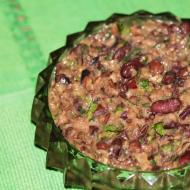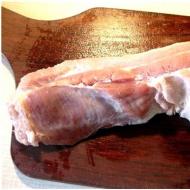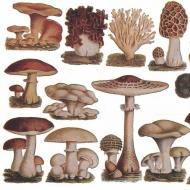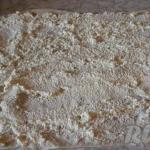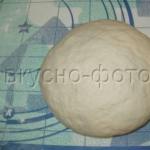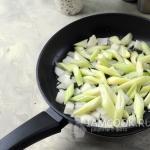
Freezing mushrooms for the winter at home. How to properly freeze mushrooms for the winter - freezing mushrooms at home What is the best way to freeze mushrooms for the winter
Autumn...Mushroom hunting is in full swing. And the mushrooms have “grown up” this year. And when there are a lot of them and you can’t eat them at once, you can prepare them for future use. And in the “off season”, have fresh mushroom soup, mushroom hodgepodge, just mushrooms fried with onions on the table, or use them as a filling for pies. Today I'll tell you how to freeze them. And in general, mushrooms are healthy, nutritious, quick to cook and... dietary, if you don’t overdo it with oil.
The mushroom season didn’t go well for me... The cast on my leg ruined my plans. Therefore, this year I am not picking mushrooms, and this is the most favorite part of the mushroom marathon, alas, I got the second part - cleaning and storing for the winter. That’s right... Because there’s no point in jumping around the dacha like a goat in the dark. All that remains is to look at the photos of last year’s quiet hunt.
What mushrooms can be frozen? White, red, boletus, honey mushrooms, boletus mushrooms freeze well... I don’t like frozen chanterelles at all, they taste rubbery.
There are two main ways to freeze mushrooms:
Boiled and raw. Each option has pros and cons.
Boiled mushrooms.
Preparation: peel, rinse (if there are small traces of worms, you can soak in salt water for 20 minutes), cut as for final cooking, boil (boil for 5-10 minutes). So three options:
- freeze with broth;
- strain the broth and freeze it and the mushrooms separately;
- Drain the broth and freeze only the mushrooms.
For example, pouring broth from porcini mushrooms into the sink is blasphemy for me, so I poured it into containers and froze. After freezing, lightly holding the container in warm water, you can transfer the frozen broth into a tight bag. But you can safely pour out the broth from mushrooms - leave only the mushrooms.
It is better to defrost in the refrigerator, you just have to remember to take the mushrooms out of the freezer the day before. You need to freeze in portions, in the size of one preparation, so as not to divide anything (this is not easy!) and not to re-freeze the excess (and this will ruin the taste of the mushrooms!)
pros:
We get a semi-finished product that is quickly prepared. Boiled mushrooms are more compact to store, i.e. take up less space in the freezer. This method is quite suitable for mushrooms that are not in the most ideal condition.
Minuses:
There is still a slight loss of taste. Mushroom soup with re-cooked mushrooms is not as rich as fresh ones, and if you freeze the broth, it takes up more space in the freezer.
Raw mushrooms.
Preparation: We clean the mushrooms from debris (+ clean the caps from the film on the boletus mushrooms, the skirts on the honey mushrooms, and clean the stems on the boletus and red mushrooms), for more compact storage, separate the stems from the caps, and cut large caps in half. DO NOT WASH! Mushrooms strongly absorb moisture; this is of no use for quality freezing. Since the mushrooms are dry, you can immediately put it in a bag with a clip, remove as much air as possible... and into the freezer. Easy to defrost: I put the bag of mushrooms in warm water, and almost immediately I separate the frozen parts of the mushrooms, rinse them in running water, immediately cut them and cook them right away, without waiting for final defrosting. This method is an advantage for me.
Mushrooms are a favorite food of millions. Every housewife knows at least several recipes where these forest guests are the key figures. A huge number of mushroom recipes are explained by the versatility of the product - the nutritional value and unusual taste of mushrooms are incomparable to anything else.
They are used for fried, boiled, steamed and baked dishes, rolled into jars and added to aromatic autumn soups.
In any dish, mushrooms exhibit a pronounced taste and fill the house with a pleasant aroma. Today we will talk about such a prominent representative of the forest kingdom as the porcini mushroom. A great idea for those who like to please themselves with the tastes of early autumn in winter would be to freeze porcini mushrooms for the winter.
Winter is not rich in fresh vegetation, and therefore freezing is the best solution for lovers of such products. And although modern supermarkets offer a huge range, finding a truly high-quality product will not be easy.
That's why you should take matters into your own hands, especially if the forest harvest season is not an empty phrase for you. Without a shadow of a doubt, all the mushroom trophies you have accumulated can be sent to the freezer, so that later, under the howls of a blizzard, you can enjoy amazing dishes from the boletus mushrooms you collected.
- Reviews and comments
Freezing mushrooms for the winter - what to remember
Freezing food at home is very easy. And if you have an impressive freezer, you can create a whole warehouse of useful supplies. Many people know that the freezing procedure requires a certain sequence, which will be discussed below.
Let's note a few important points that are worth paying close attention to:
- all your boletus mushrooms must be clean and fresh - a stale product will not particularly please you with its delicate taste in the cold winter;
- appearance affects the quality after defrosting - make sure that the boletus mushrooms are whole;
- at home, before freezing, carefully clean porcini mushrooms from particles of soil and other things;
- try not to wet the fresh product too much, as it absorbs moisture very quickly;
- monitor the temperature in the freezer - if it is stable and approximately -18 degrees, then your product will last up to a year;
- defrost mushrooms only in the refrigerator - this will help them convey their natural taste as accurately as possible;
- After defrosting, use the product as quickly as possible, do not store it in the refrigerator for too long.
Freezing mushrooms for the winter - simple recipes
The good thing about a raw product is that you will have plenty of room for thought when you decide to remove the product from the freezer during the cold season.
In this case, freezing requires you to have whole and as fresh porcini mushrooms as possible. In addition, the stronger the boletus, the better its shape will be after defrosting. After cleaning, you need to spread your forest harvest on a flat surface directly in the freezer, and after a few hours place it in a plastic bag or a special plastic container.
You can also freeze porcini mushrooms in sliced form.
To do this, you will need to cut them into pieces of 7-10 mm, then dry them thoroughly and distribute them into even portions, calculating how much you will need to prepare the dish. Place each of these portions in plastic bags, then try to remove all the air from them.
How to prepare boiled porcini mushrooms
Freezing an already prepared product for the winter is a great solution for those who save their time. However, not everyone trusts freezing raw food, so pay attention to this recipe for freezing mushrooms for the winter.
You don't have to cook it for long - just 5 minutes. You should not use salt to create the product. Boil the boletus mushrooms in boiling water for 5-6 minutes, then give them time to cool and distribute into bags. Usually 300-500 g of product is placed in one package, which is ideal for preparing one dish.
This method is also suitable for a product that has lost its original appearance for some reason. Often the workpiece is used for subsequent frying.
Freeze fried mushrooms
Another recipe shows us that the number of freezing methods is inexhaustible. This procedure differs from the previous one mainly in that instead of boiling the product we will use the frying method.
Place boletus mushrooms, chopped at your discretion, into a heated frying pan, pre-greased with vegetable oil.
Do not use salt or pepper - this is not necessary in the preparation, and the freezing technology does not involve the use of spices. You can add salt and seasonings to the finished dish once you have thawed the porcini mushrooms.

Fry the workpiece for 20 minutes until all the moisture has evaporated and the boletus mushrooms themselves have acquired a nice blush. Let them cool by spreading them out on a flat surface, then feel free to pack them in food bags or containers and put them in the freezer. By the way, a frying pan is not the only option for frying.
You can also use a baking sheet and oven. In this case, you don’t even need vegetable oil, because the product will be cooked in its own juice.
Freezing chanterelle mushrooms for the winter
Chanterelles are rightfully considered one of the most delicious representatives of the mushroom kingdom. Their delicate consistency and unique flavor are difficult to confuse with anything else. And dishes with chanterelles have sophistication and beauty. If you are lucky enough to collect or purchase fresh chanterelles, be sure to freeze some of them for the winter - dishes with this product will become a table decoration for any celebration or just a family dinner.
Chanterelles are very often rolled and pickled, but it is the original taste that most often helps create a unique flavor palette in certain dishes. And the proven freezing method will help preserve it along with all its beneficial properties.
The main thing to remember is that these beauties do best when frozen properly when fresh. It is advisable to start the procedure on the day of collection or purchase.
Having weeded out unsuitable specimens and cleared them of debris and dust, we wash them under running water. Next, lay the chanterelles on a dry towel and give them time for all unnecessary moisture to evaporate. The dried pieces can now be distributed into bags and placed in the freezer.
If you don’t like the bitter taste too much, you can freeze the chanterelles in their boiled form.

To do this, place them in an enamel container and fill with water, then bring to a boil and leave on low heat for 15-20 minutes. Pour the boiled chanterelles into a colander, rinse and dry.
Cooled mushrooms, as in previous cases, can be packaged in bags or containers, calculating the quantity for preparing the dish. Don't forget that the best temperature in the freezer is -18 degrees.
You can also prepare chanterelles, pre-boiled or stewed, along with liquid. This preparation is perfect for soups or stews. However, with this method it is worth remembering that a frozen product can be stored for a maximum of 4 months.
Freeze chanterelles in any way you like. Delight yourself and your household with amazing mushroom dishes every day!
Today you can buy it both at the market and in the store. But homemade still remains relevant. People prefer to prepare mushrooms themselves, since this is not a very simple product and no one can guarantee that you will buy a quality product in the store. That is why we decided to talk about freezing and offer several popular recipes.
How to prepare mushrooms for freezing
Boletus purchased in a store or collected independently must be sorted out, removing spoiled and wormy ones, trimming the edges of the legs, peeling and thoroughly wiping with a brush or dishwashing sponge.
Important! You cannot wash boletus mushrooms before freezing.
If the product is very dirty, it can be lightly rinsed under running water, but never soak. The fact is that the cap, which has a porous surface, quickly absorbs moisture, and excess liquid is not needed during freezing. It is also important to follow the following rules:
- must be fresh, strong and young.
- If it has greenish-yellow pores, it is better to cut them off. After defrosting, they will become soggy and ruin the dish.
- If the worminess has spread from the legs to the cap, the mushroom should be discarded.
Freezing methods
There are several ways to freeze for the winter, and each of them has its own advantages. The fastest way is to freeze boletus mushrooms raw. But recipes for freezing boiled and even stewed are also popular. And which option is the most practical, you can decide after you try each one yourself.
Did you know? The boletus cap has a yellow or green tint underneath, while the false mushroom- rather dirty. In addition, if the stem is broken the color remains white- a sign that this is a boletus. In false mushrooms, the scrap instantly turns pink.
Raw
This - the easiest and fastest way to prepare boletus for the winter. To do this, small, old mushrooms are selected, cleaned, washed and dried so that they do not stick together later.
The prepared mushrooms are spread on a tray, tray or flat plate (the layer should not be thick) and placed in the freezer for several hours. Then the mushrooms are taken out and laid out in portions (so that there is only enough for one time) in bags or containers.
A regular bag is more convenient because it can take any shape and excess air is easily removed from it. If storage is in containers, it is better to fill them completely so that no air remains.
If the freezer is not large or there is not enough space, you can pre-cut the mushrooms into pieces.
Important!The parts should not be thin. The best thickness for freezing is 5-7 mm.
Boiled
Many people prefer to store boiled mushrooms frozen, because boiled mushrooms take up little space in the freezer. But not everyone knows how to cook porcini mushrooms for freezing. It turns out it's not difficult.
As in the version with raw products, before harvesting the mushrooms are cleaned, washed and cut. After this, they are lightly boiled, plunging into boiling unsalted water for 5 minutes(possibly lightly salted) water.
After boiling, place the mushrooms in a colander or sieve to drain the water. Then put it in bags or plastic containers and put it in the freezer.
The decoction obtained during preparation for freezing is not poured out, but boiled until thickened. Then it is cooled, poured into plastic containers or ice containers and also frozen. Then this decoction can be used to prepare sauces or soups.
It is advisable to store boletus mushrooms in a separate compartment, away from meat and fish.
Important!Since mushrooms are able to absorb both beneficial and toxic substances, boiling is more beneficial- all harmful components pass into the water.
Fried
There is another way to freeze porcini mushrooms without cooking. It differs from the previous ones only in that the product will need to be fried.
This is not at all difficult to do: mushrooms in vegetable oil fry until moisture comes out, and the mushroom itself will turn beautiful blush. There is no need to add salt or spices. All these procedures can be done after defrosting, when preparing the dish.
Place the mushrooms from the frying pan on a tray, dish, baking sheet or board and allow them to cool. After this, they are laid out in portions into bags or containers and placed in the freezer.
Shelf life
If the porcini mushrooms were processed according to all the rules before freezing, they can be stored 6-8 months(only in the freezer). Moreover, throughout this period they will retain their aroma and taste properties.
The temperature in the freezer should be -18°C.
Did you know? Until the end of the twentieth century, they were considered, and today they are classified as and in many countries their consumption is prohibited. Scientists have proven that it contains muscarine, which remains even after heat treatment and can provoke blood diseases and cause allergic reactions.
Defrosting rules
Having found out whether fresh mushrooms can be frozen, I want to find out how to defrost them. Experts say that defrosting should take place gradually, by moving boletus mushrooms from the freezer to the refrigerator overnight. Then they should be kept for 3 hours at room temperature.
After defrosting, the product must be used immediately; after re-freezing, the mushrooms will turn into a shapeless mass.
To prepare some dishes, preliminary defrosting is not required; the product is immediately used frozen. For example, when preparing first courses (soups), mushrooms are immediately thrown into boiling water and boiled until completely cooked.
With the onset of autumn, our forests are filled with a huge number of mushrooms. However, if you are not a fan of following them into the forest, this is not at all scary. There are no less of them on market shelves. Main - When choosing mushrooms, follow certain rules in order to get a truly tasty and healthy product for your table.
You can prepare many delicious dishes from mushrooms. Moreover, you can delight your home with culinary masterpieces not only in the fall. Honey mushrooms, chanterelles, boletuses, and oyster mushrooms can be present on your table in winter.
Especially for you, KitchenMag has analyzed several ways to prepare mushrooms for the winter, which will help preserve almost all the beneficial substances and taste. It is important to remember that only fresh mushrooms are suitable for any canning method.
1. How to dry mushrooms
This method is suitable for porcini mushrooms; dried boletuses are also especially tasty. But sometimes chanterelles are also dried. There are special rules that must be followed in order to properly dry mushrooms. So, before drying, mushrooms are not washed so that they do not absorb excess moisture. Mushrooms should be coarsely chopped, as they will dry out 3-4 times. Small mushrooms can be dried whole, but it is better to separate the stem from medium ones.Since there are not many sunny days in autumn, it is best to dry mushrooms in a stove or oven. Place the mushrooms on a baking sheet in a single layer, place in the oven, and leave the lid ajar to allow air access. Set the oven to 70-80 degrees and dry for several hours. If the mushrooms are not dried enough, you can put them in the oven in several stages.
It is best to store dry mushrooms in a dry place in a glass or ceramic jar. Some mushrooms can be ground in a coffee grinder, so they will take up less space. In addition, they will be needed for sauces and flavoring of dishes.
An important point: before cooking, dried mushrooms must be washed well and soaked in hot water for 2 hours. This water should never be used for making soups.
2. How to freeze mushrooms
Before freezing mushrooms for the winter, carefully sort them out and clean them of soil and leaves. Young and firm mushrooms are best suited for this purpose. You can freeze fresh, uncooked mushrooms. Honey mushrooms, champignons, chanterelles, aspen and boletus mushrooms are especially suitable for freezing in this way. These mushrooms are very strong, so you can safely freeze them raw.To do this, mushrooms should be cleared of leaves and soil. It is not necessary to wash them, but if you do, then you need to dry them well afterwards, laying them out on a towel. Place dry mushrooms in a thin layer of plastic bag and place it in the freezer. It is better to defrost raw mushrooms in the refrigerator. After such a soft defrosting, they will be just like fresh, as if from the forest.
If you are afraid to freeze raw mushrooms, you can pre-boil them for five minutes. You can use mushrooms of absolutely any size. If they are too big, cut them into small pieces. After you have boiled the mushrooms, let them cool and drain in a colander. to drain excess water. Then place the mushrooms in bags, seal tightly and place in the freezer.
Please note that thawed boiled mushrooms are an excellent place for the growth of various bacteria, so calculate that the number of mushrooms in one package is necessary for preparing one dish.
3. Pickling mushrooms
You can use any mushrooms for pickling, as long as you like them. However, this also has its own characteristics: saffron milk caps are often salted raw, and honey mushrooms like to be pickled. It is the small crispy mushrooms that will look best on any table and will be remembered by your guests for a long time. In general, before pickling mushrooms, they should be cut into equal slices. This way the marinade will saturate them equally.
There are a lot of recipes for salted and pickled mushrooms. However, when choosing one of them, it is important to remember that the most important thing in this method of harvesting mushrooms is safety. The fact is that homemade salted and pickled mushrooms often become the cause of an infectious disease - botulism. To prevent this, you need to follow simple rules and create conditions so that carrier bacteria cannot multiply.
First, create an acidic environment, that is, add lemon or vinegar. The lid should not be tightly closed, because bacteria multiply with triple force in such conditions. Be sure to sterilize all jars and lids. To do this, you just need to boil them. By the way, if you add more salt to the water, the boiling point will increase, and this is additional protection against botulism. Store jars at temperatures below 10 degrees.
How to freeze mushrooms?



We are accustomed to the fact that mushrooms need to be pickled or salted for the winter; especially diligent housewives also dry mushrooms. But salted mushrooms are good mainly as an appetizer; they cannot be used to make a flavorful, rich soup, pizza topping, or delicious julienne. And in winter, sometimes you really want to remember summer and taste fried potatoes with mushrooms! In this case, only frozen mushrooms can help out; when cooked, they taste indistinguishable from fresh ones. Do you doubt whether you can freeze mushrooms for the winter yourself? You can freeze mushrooms, but this issue has its own nuances. You will learn about them from the article. And in this article we will look in detail at the process of freezing mushrooms.
What mushrooms can be frozen?
You can freeze almost all types of edible mushrooms, but if there is not so much space in the freezer compartment of your home refrigerator, it makes sense to freeze porcini, Polish, chanterelles, boletus, saffron milk caps, boletus and aspen mushrooms. Freezing porcini mushrooms is described in detail in a separate article. Champignons also freeze well, but since they do not disappear from store shelves all year round, there is simply no need to prepare them for the winter.
How to freeze whole fresh mushrooms for the winter?
Mushrooms can be frozen whole - this method is especially good for porcini, polish, saffron milk caps and butter mushrooms. It is better to remove the brown slimy skin from butter before freezing. In boletus and aspen mushrooms, the stems are hard and fibrous, not of particular nutritional value, so in these two species the stems are usually broken off and only the caps are frozen.
Mushroom selection
For freezing, it is necessary to select young, strong mushrooms of small size that do not have spots or mechanical damage. The mushrooms must be fresh, collected on the same day, or at least the day before. You only need to freeze one type of mushroom. Under no circumstances should wormy mushrooms be frozen.
Preparing mushrooms
- Mushrooms should be carefully sorted, mercilessly discarding all that do not meet the above criteria.
- Next, the mushrooms must be cleared of forest debris - blades of grass, sand, pine needles and leaves. This can be done conveniently with a soft brush or sponge.
- If the mushrooms are very dirty, they need to be washed. You should wash the mushrooms one at a time, quickly rinsing them under running water - this way they will not become saturated with moisture and will not become soggy.
- After washing, the mushrooms should be dried by spreading them on a kitchen towel.
- When the mushrooms are dry, you can start freezing them.
Freezing mushrooms
Place the prepared mushrooms in one layer on a tray so that they do not touch, and place the tray in the freezer. The lower the temperature in the freezer, the better. If your refrigerator has the “Enhanced Freezing” function, which allows you to set the temperature in the freezer to 24*C, be sure to turn it on.
After 12 hours, check the quality of the freezing. If the mushrooms ring like pebbles when you tap each other, it means they can be packaged in thick plastic bags or plastic containers. Two small useful packaging tips:
- Provide each package with a label on which you write the type of mushrooms and the date they were frozen.
- Since mushrooms cannot be re-frozen, pack them in small portions so that one package is designed for preparing one dish.
Place the mushrooms packaged in this way in the freezer and store them there for no more than six months at a standard temperature of -18*C.
Other ways to freeze mushrooms
Good quality mushrooms that have slight mechanical damage or mushrooms that are too large can also be frozen for the winter. To do this, sorted and peeled substandard mushrooms must be cut into thin (3 - 4 mm) slices before freezing, removing damaged areas when slicing. Next, treat the sliced mushrooms in the same way as with whole ones - place the slices on a tray and put it in the freezer. Sliced mushrooms freeze faster than whole ones. After about six hours, they can already be put into bags and put in the freezer for storage.
Mushrooms for the winter can be frozen not only raw, but also boiled or stewed with a small amount of vegetable oil.
To do this, prepare the mushrooms as described earlier, then cut them into slices and boil for 10 minutes in salted water or simmer in a deep frying pan until almost done. The boiled mushrooms are placed in a colander, after the liquid has drained, placed in portioned food containers, tightly closed with lids and allowed to cool to room temperature. Stewed mushrooms are packed into containers along with the juice that they released during stewing, and also cooled. After this, the containers with mushrooms are signed and put into the freezer, where they freeze and are subsequently stored.
And fruits, in addition to cans, are also sent to the freezer - for better preservation of vitamins.
But there is another type of preparations that many housewives practice, namely those collected or purchased for the winter, and this process is worth considering in more detail.
What mushrooms are suitable
Fans of “silent hunting” know that almost anything is suitable for such purposes. But preserves its taste best:
- boletus;
- boletus;
- saffron milk caps;
Most often, purchased oyster mushrooms or. This is the easiest option for city dwellers - not everyone has a forest nearby, and collecting “wild” ones without proper experience is problematic.
Important! A filled container or bag should contain a minimum of air, which accelerates the “aging” of products. Therefore, the containers are filled to the very top, and the air is “bleeded” out of the bags before sealing.
Logging is more preferable (after all, it is a “natural product”), but there are some nuances here too. The collection should only contain young plants taken from the edge of the forest in the depths of the massif. Roadside ones are not suitable for food (due to their ability to absorb harmful substances through).
Preparing mushrooms
Primary processing is done immediately after collection. Ideally - within 24 hours. The most demanding ones in this regard are boletus mushrooms, trumpet mushrooms, etc. Having such a collection in hand, you will have to act as quickly as possible.
Other species (especially oyster mushrooms) can withstand 1.5-2 days, although this should not be abused - useful substances and compounds “evaporate” quite quickly.
Otherwise, preparation at home is quite simple; mushrooms, before being frozen, are subjected to such simple procedures:
- a thorough inspection - all old, cracked, limp or simply suspicious specimens are put aside;
- all rubbish and dirt are removed from the remaining ones;
- then follows a thorough rinsing with a change of water (in this case, some of the beneficial properties will be lost, but safety is paramount);
- After washing, they are laid out on a towel and dried.
Already dry mushrooms are ready for further processing and freezing. The largest ones are carefully cut, while the smaller ones are tried to be left whole (although for a small freezer, they will also have to be cut).
Freezing methods
Having already washed mushrooms, you can proceed directly to freezing. Let's start with the simplest method that will help preserve the newly collected material.
Raw mushrooms
The algorithm for such work will be as follows:
- Mushrooms are scattered evenly over containers or tray. The layer should be thin.
- Then the container is left in the freezer for 12 hours, turning up the maximum setting.
- After this time, the workpiece is removed, and the mushrooms themselves are distributed into ordinary plastic bags. They are placed in the freezer, already operating in standard mode.
Many people are interested in which mushrooms from the mentioned list can be frozen, taken raw, and whether they really retain their nutritional qualities using such a simple method.
Important! The ideal storage container would be a container made of so-called kraft cardboard with walls and bottom laminated on the inside.
“High-speed” freezing without preliminary heat treatment best suited for purely forest species, such as:
- chanterelles;
- boletus;
- boletus;
- (collected at the forest edge, not purchased).
Boiled
It happens that the collected specimens seem to be intact, but their condition falls a little short of “saleable appearance”. In such cases it helps short cooking:
- Place a large saucepan over medium heat. It’s easy to calculate the volume - 5 liters of water per 1 kg of collection.
- The already washed and cut workpiece is placed in the pan, which will be boiled for 5-10 minutes.
- After turning off the gas, you need to let the boiling water cool a little and then remove all the pieces with a colander, draining the water. Some mushrooms are dried, but this is not necessary.
- All that remains is to place the mushrooms in bags and put them in the freezer. They are packaged so that one bag or container is enough to prepare one dish - after opening the cellophane in winter, the product is immediately sent for cooking (when melted, it very quickly loses vitamins and minerals, and the taste becomes less rich).
The question that remains relevant is whether it is possible to freeze absolutely whole mushrooms by simply taking them raw and without boiling them before sending them to the chamber.
Practice suggests that nothing bad will happen, but there is one culinary trick. If you freeze such products for making soup, then you don’t have to scald them, but for future frying this procedure is required.
Stewed
This method allows preserve the aroma without much destruction of the structure of the stem or cap:
- The blanks are soaked in a solution of water with citric acid (1 tsp per 1 liter). Leave for 5-7 minutes.
- Then they throw it into a heated frying pan, after pouring a little vegetable oil into it.
- Set the heat to high and stir for 4-5 minutes. To enhance the taste, you can add (chopped or rings). This “set” is fried for another 2-3 minutes.
- It remains to simmer under the lid for 15-20 minutes, not forgetting to lightly pepper and salt at the end.
- Turn off the gas and let the mushrooms sit for a while under the lid.
Important! If during prolonged cooking the mushrooms begin to turn slightly gray and wrinkle, this is not a cause for concern. On the contrary, such a signal indicates the final “exodus” of microbes and harmful impurities.
The final chord is cooling and placing in containers or bags. It turned out to be an excellent base for pasta, which is sent to the freezer.
Fried
There is no particular difficulty here either:
- Drop 2 tablespoons of vegetable or oil into the pan.
- When it warms up over medium heat, you need to lay out the chopped collection in a thin layer.
- The duration of frying may vary depending on the size - 4-5 minutes are enough for small pieces, while larger ones can take 10-15.
- Then comes cooling (you don’t have to cover it with a lid).
- Then everything is as usual: packaging and going to the refrigerator. The resulting product, left there until winter, will be an excellent filling.
Often such processing is carried out not on the stove itself, but in the oven. This is even more economical - no oil is required (it is replaced by your own juice). True, old stoves can produce uneven heating, and this point should be kept in mind even before frying.
How long can they be stored?
After all this work, a logical question arises: how long can you keep and store packaged and frozen mushrooms in a regular freezer?
- All edible mushrooms are suitable for freezing, but more than others are strong and worm-free young porcini mushrooms, aspen mushrooms, boletus mushrooms, champignons, chanterelles, and honey mushrooms.
- Mushrooms are a very delicate product and therefore require careful attention and processing as quickly as possible. The best thing is to put them in storage on the same day they were collected in the forest or bought at the market.
- How to freeze mushrooms? The principle of freezing wild mushrooms is generally similar to freezing berries. The mushrooms must be carefully sorted, discarding questionable and wormy mushrooms, trimmed, removed damaged parts and rinsed thoroughly, changing the water several times. It is best to freeze whole young, strong mushrooms, which are rarely wormy. Dry the washed mushrooms on a towel, cut large ones, then place them on a baking sheet or tray in one layer and place in the freezer. The answer to the question “how to freeze porcini mushrooms” is exactly the same.
- Place frozen mushrooms in a bag or container, tie, label (be sure to write the date of storage and type of mushroom), and store in the freezer.
- Remember that thawed mushrooms are a favorable environment for the proliferation of various microorganisms, so after thawing, mushrooms should be immediately used for preparing mushroom dishes.
- Frozen mushrooms are stored in a freezer at -18°C for up to one year.
Is it possible to freeze fresh mushrooms?
If you are afraid to freeze fresh mushrooms, boil them before freezing for 5 minutes in boiling salted water, drain in a colander, dry and only then freeze.
Label containers and bags of frozen mushrooms - when cooked, they look like a homogeneous mass. Fill containers completely. The less air left in the container, the better the food will be preserved in it. The same rule applies to plastic bags: squeeze out as much air as possible from them, tie them, and then put them in the freezer. Now you know everything about how to properly freeze mushrooms!
You can freeze almost all types of mushrooms (edible, of course): chanterelles, honey mushrooms, champignons, and so on. The only exception is the porcini mushroom. Of course, you can freeze it, but it’s better to dry it, so the aroma will be fully preserved.
Step one - sorting
As soon as you return from the “quiet hunt”, immediately sort through and sort the gifts of the forest according to the structure of the cap:
- marsupials (morels, saucers, truffles);
- lamellar (chanterelles, milk mushrooms, russula, honey mushrooms, champignons);
- tubular (ceps, aspen mushrooms, fly mushrooms, boletus mushrooms).
All mushrooms in their raw form take up too much space in the freezer, so they are usually subjected to heat treatment - the volume is reduced by 4-5 times.
Lamellar and marsupial mushrooms must be boiled. It is preferable to freeze only the tubular ones raw; they have a porous sponge cap that absorbs a lot of liquid during cooking; as a result, the mushrooms can turn out watery. Therefore, if you decide to cook them, do not forget to squeeze them with your hands.
Preparing to Freeze
Clean the sorted mushrooms from debris with a knife and cut off the lower part of the stem. If the caps are very dirty, then they also need to be cleaned with a knife or sponge.
If you plan to freeze mushrooms raw, then wipe them with a damp sponge or rinse them with water, but do not soak them (!), and then dry them on a towel. If you boil or fry, you can safely throw it in a bowl of water to soak up the dirt particles, and before you start cooking, simply squeeze out the excess water with your hands.
How to freeze mushrooms raw
Only tubular mushrooms can be frozen raw. Leave small specimens whole, cut large ones into segments 1-2 cm thick. Place the mushrooms on a flat tray in an even layer and put them in the freezer for a couple of hours. As soon as they freeze, pack them in bags or special containers.
Rules for freezing boiled mushrooms
You can chop the mushrooms that you plan to boil or leave them whole if they are small. Next, put them in boiling water and cook for 15-20 minutes. Drain in a colander, cool and freeze in portions so you can use them at a time.
How to freeze boiled mushrooms - step-by-step recipe
Using the flywheel mushroom as an example, I will tell you in detail how to freeze wild mushrooms for the winter. The gifts of the forest will first be boiled, and then go into the freezer for storage. In this form they will be edible for 4-6 months (temperature minus 14°C).
Total cooking time: 60 minutes
Cooking time: 20 minutes
Yield: 6 servings
Ingredients
- fresh mushrooms – 1-1.5 kg
- water – 3 l
- salt – 1 tsp.
- onions – 1 pc.
Preparation
Big photos Small photos
In this form, the product can be stored for up to six months. Mushrooms are ready to use and can be added to soups, pie fillings, and so on.

How to defrost correctly
Raw frozen mushrooms are first thawed in the refrigerator on the bottom shelf, and then kept at room temperature for some time, but not more than 1 hour.
Boiled mushrooms are already ready to use. They do not need to be defrosted first; they can be immediately added to soups and other dishes during cooking.
Be sure to spend a little time on the same day and prepare yourself a fragrant delicacy for the winter. After all, it’s terribly nice to cook, for example, mushroom risotto or julienne in winter and show off to your guests the autumn trophies of the “silent hunt” stored in the freezer.
Mushrooms can spend a great time in the freezer almost until the next season, although they rarely succeed in this, they are very tasty.
I’ve been freezing mushrooms this way for 8 years now, I read it in some culinary magazine. The method is simple, and the mushrooms are guaranteed to be well stored, and in addition, they completely retain their taste and aroma. When cooked, you can hardly tell them apart from freshly picked ones.
We grow white, Polish, boletus, and boletus. I froze all these mushrooms, and the results were equally good with all of them.
Immediately upon returning from the forest, I begin cleaning the mushrooms. I cut off the rough bases of the legs, clean the mushrooms from adhering needles and leaves. Then I wash them very quickly, one at a time, without keeping them under running water for a long time, so that the mushrooms do not become saturated with water, like a sponge. Place the washed mushrooms on a towel and dry.
Now you need to cut the mushrooms. Very small ones can be left whole, the rest can be cut into the same slices as you usually cut them for cooking, so that you can later use the mushrooms straight from the freezer without subjecting them to additional manipulations.

While I’m chopping the mushrooms, a large pot of water is boiling on the stove, a big one, about five liters. The water has boiled and you can begin the process of harvesting mushrooms.
I freeze mushrooms, as well as fruits and berries, on glass cutting boards, and then transfer them to storage bags. I put portions of chopped mushrooms in boiling water and blanch for 2 minutes. I take it out with a slotted spoon and lay it out on the boards. Once it cools down I put it in the freezer. After about five hours, the mushrooms will freeze and you can transfer them from the boards to bags by picking them up with a knife.
What does blanching do? Firstly, it additionally disinfects the mushrooms before storage, and, secondly, the ice crust keeps the mushrooms juicy and prevents them from drying out during freezing.
When I need to cook something from frozen mushrooms, I do the following. If you need mushrooms for soup, then I put them straight without defrosting. And if for frying or some kind of dish, then I first boil the frozen mushrooms in a slow cooker for about 10 minutes, and after that you can fry them, stew them, etc.



